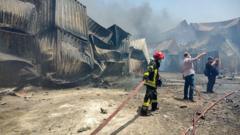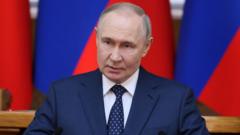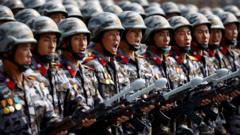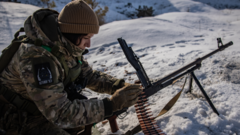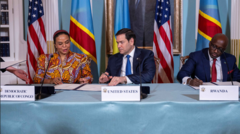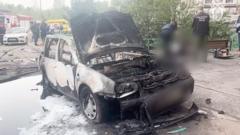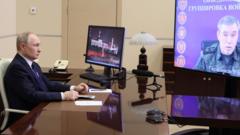As the conflict in Ukraine approaches its fourth year, more than 95,000 Russian soldiers are confirmed dead, with many more casualties from militia forces. The death toll is compounded by limited social integration of those affected in Russian society, particularly among marginalized groups and convicts forced into combat roles.
Unseen Sacrifices: The Unreported Toll of Russian Troops in Ukraine

Unseen Sacrifices: The Unreported Toll of Russian Troops in Ukraine
Over 95,000 soldiers fighting for Russia have perished in the ongoing war in Ukraine, yet this figure likely underrepresents the true loss of life on the battlefield.
Article text:
As the war in Ukraine enters its fourth year, the toll on Russian military personnel remains alarming, with over 95,000 confirmed dead according to data analyzed by the BBC. This figure does not account for the fatalities among the self-proclaimed Donbas republics, which is estimated to be between 21,000 and 23,500 fighters. Independent media groups like Mediazona and volunteers have been diligently documenting casualties since the full-scale invasion commenced in February 2022. Utilizing various sources, including official reports and memorials, they believe the actual death toll could be significantly higher.
The story of Daniil Dudnikov, a 21-year-old history student at Donetsk National University, encapsulates the grim reality faced by many. He was forcefully mobilized on the first day of the invasion and was reported missing just a month later. The subsequent confirmation of his death reflects the experiences of countless individuals and families caught in the relentless wave of conscription from the Donetsk and Luhansk regions, territories held by Moscow-backed separatists since 2014. The hasty mobilization of civilians, often with minimal training and inadequate equipment, has resulted in staggering losses among Russian forces.
Notably, a significant portion of the Russian casualties comprises convicts, who have been recruited under dire conditions. The story of Ildus Sadykov, a 59-year-old man sentenced for theft, illustrates the bleak choices offered to inmates; sign up to fight or face imprisonment. His capture and subsequent return to combat resulted in his death at the frontlines, joining the ranks of more than 16,171 criminals verified to have been recruited to fight.
Research indicates that the burden of war disproportionately affects less privileged segments of Russian society, fostering a disconnect from the broader populace. This dissonance sees only a minority of Russians, approximately 30%, having direct ties to the war, while an overwhelming 80% of Ukrainians report knowing someone affected by the conflict. In light of this, sociologist Viktor Vakhshtayn questions whether the public’s perception of the war would shift if more Russians were personally acquainted with those who have fallen.
As a result of underreporting and hidden casualties, military analysts estimate that the actual number of Russian military deaths could range between 146,194 and 211,169. Recent observations indicate that the bodies of many soldiers remain unretrievable on the battlefield. Meanwhile, Ukraine's military casualties, considered to be underreported as well, have reached around 70,400.
As discussions about potential peace negotiations emerge, attention is increasingly drawn to the realities of prolonged conflict. Efforts to keep track of military losses continue as we analyze new data from cemeteries, memorials, and obituaries, which have notably surged since September of the previous year. In this ongoing crisis, the human cost of war, often hidden from public view, continues to mount.
As the war in Ukraine enters its fourth year, the toll on Russian military personnel remains alarming, with over 95,000 confirmed dead according to data analyzed by the BBC. This figure does not account for the fatalities among the self-proclaimed Donbas republics, which is estimated to be between 21,000 and 23,500 fighters. Independent media groups like Mediazona and volunteers have been diligently documenting casualties since the full-scale invasion commenced in February 2022. Utilizing various sources, including official reports and memorials, they believe the actual death toll could be significantly higher.
The story of Daniil Dudnikov, a 21-year-old history student at Donetsk National University, encapsulates the grim reality faced by many. He was forcefully mobilized on the first day of the invasion and was reported missing just a month later. The subsequent confirmation of his death reflects the experiences of countless individuals and families caught in the relentless wave of conscription from the Donetsk and Luhansk regions, territories held by Moscow-backed separatists since 2014. The hasty mobilization of civilians, often with minimal training and inadequate equipment, has resulted in staggering losses among Russian forces.
Notably, a significant portion of the Russian casualties comprises convicts, who have been recruited under dire conditions. The story of Ildus Sadykov, a 59-year-old man sentenced for theft, illustrates the bleak choices offered to inmates; sign up to fight or face imprisonment. His capture and subsequent return to combat resulted in his death at the frontlines, joining the ranks of more than 16,171 criminals verified to have been recruited to fight.
Research indicates that the burden of war disproportionately affects less privileged segments of Russian society, fostering a disconnect from the broader populace. This dissonance sees only a minority of Russians, approximately 30%, having direct ties to the war, while an overwhelming 80% of Ukrainians report knowing someone affected by the conflict. In light of this, sociologist Viktor Vakhshtayn questions whether the public’s perception of the war would shift if more Russians were personally acquainted with those who have fallen.
As a result of underreporting and hidden casualties, military analysts estimate that the actual number of Russian military deaths could range between 146,194 and 211,169. Recent observations indicate that the bodies of many soldiers remain unretrievable on the battlefield. Meanwhile, Ukraine's military casualties, considered to be underreported as well, have reached around 70,400.
As discussions about potential peace negotiations emerge, attention is increasingly drawn to the realities of prolonged conflict. Efforts to keep track of military losses continue as we analyze new data from cemeteries, memorials, and obituaries, which have notably surged since September of the previous year. In this ongoing crisis, the human cost of war, often hidden from public view, continues to mount.

